The road to good health starts during childhood when good habits for optimal wellness are formed. But, any parent can tell you that embedding these behaviors in a child isn’t always easy.
Every generation has known children to be fussy eaters, but today’s youth often have special dietary constrictions on top of that (think gluten-free, meat-free, lactose-free and the like). Plus, we are inundated with enticing messages from junk food companies, leading many children to tip the scales before they’ve mastered long division. Too many of America’s youth are eating too much, and yet are malnourished.
To help get kids off to a good start on their journey toward healthy lives, retailers should be sure to educate parents about appropriate dietary choices for their families—as well as when and how to supplement.
Filling Nutritional Gaps in Children with Special Diets
Vegans and vegetarians. Vegan and vegetarian families often raise their children with great nutritional smarts (1, 2). But, Lester Burks, CMO of Life Line Foods, LLC, Pikeville, TN, cites an article that says, 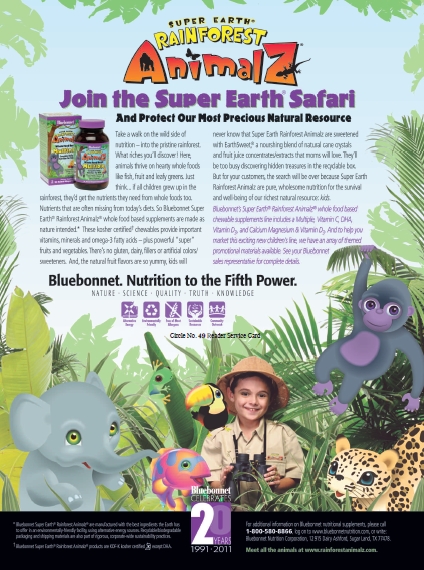 “[Vegetarian and vegan children] do have nutritional concerns that parents should be intentional about.”
“[Vegetarian and vegan children] do have nutritional concerns that parents should be intentional about.”
This is especially true of “Carbivores,” a term used by Chris D. Meletis, N.D., director of science and research for Trace Minerals Research, Ogden, UT, to describe a certain type of vegetarian. “Over the almost 20 years of clinical practice, I have noted there are two types of vegetarians: true ‘Veggivores’ in sharp contrast to Carnivores, or the more common ‘Carbivore,’” he states. Carbivores don’t eat animal products, and often add a ton of carbohydrates to their diets rather than veggies. “Many kids appear to have a natural aversion to vegetables, and even those kids raised by vegetarian parents have an affinity to carbs as they indulge the ever-present sweet tooth,” he states, recommending that vegetarian children consume a good-tasting green drink and a multivitamin daily.
Vegan and vegetarian children may also be avoiding fish, and therefore not getting the DHA they need to support brain, heart and eye health. “Today, there are non-fish, vegetarian options on the market,” says Sarah Sullivan, director of strategy and new product planning at Martek, now a division of DSM Nutritional Products, Parsippany, NJ, recommending a new DHA powder and gummy from her firm that offers 100 mg of DHA per serving (BrainStrong Toddler and Kid’s).
Jolie Root, nutritionist and educator for Carlson Laboratories, Arlington Heights, IL, agrees, stating, “Algae source DHA supplements are available to supply DHA or parents could consider adding a marine source DHA/EPA supplement to be sure their children are well nourished.”
If kids (and adults, for that matter) don’t get enough DHA, a host of problems could ensue. “Omega-3 deficiency is a significant problem and could affect mood, cognitive development, inflammation, immunity and other bodily systems in a growing chil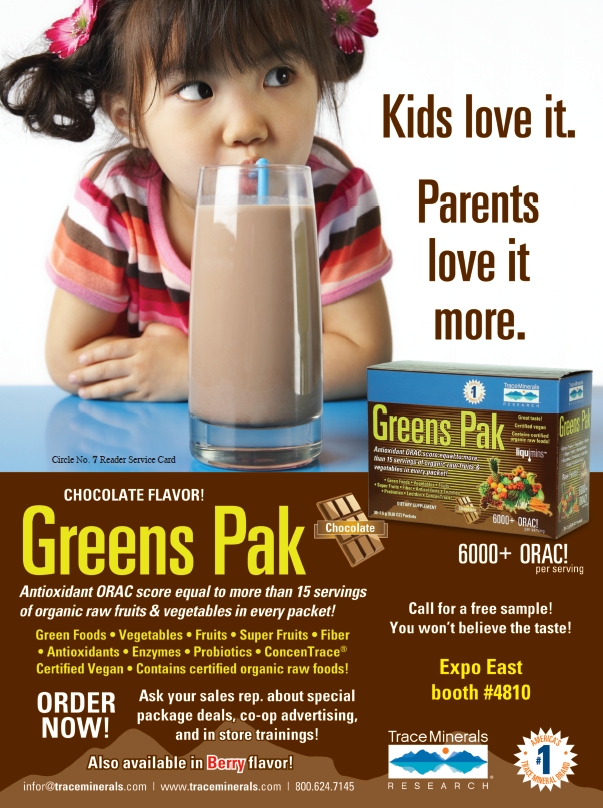 d’s body,” warns Keri Marshall, M.S., N.D., chief medical officer of Nordic Naturals, Watsonville, CA.
d’s body,” warns Keri Marshall, M.S., N.D., chief medical officer of Nordic Naturals, Watsonville, CA.
Another vegetarian option for essential fatty acids is, of course, plant-based omegas. Burks suggests flaxseed and hempseed oils as two sources that are rich in ALA (which can convert to EPA and then DHA in the body).
Another nutrient vegetarian and vegan families should be concerned with is vitamin B12. This vitamin is most prevalent in animal sources, so supplementation is a good idea. Iron, calcium and zinc, too, are common in meat and dairy, but families may not need to be as worried about these. “If parents are maintaining a varied diet rich in leafy greens, sea vegetation, nuts and seeds and legumes, a child’s daily requirements of these minerals can be met,” according to Dan Chapman, founder and CEO of Redd Remedies, Bradley, IL.
Another trick for iron, according to Audra Foster, N.D., Family & Women’s Health, Santa Cruz, CA, is that its absorption from foods can be increased by eating foods containing vitamin C. Other minerals can be problematic, too. Since vegan and vegetarian kids often have a high-fiber diet, says Foster, they can have trouble absorbing zinc, iodine and selenium in the intestine.
Parents of vegan and vegetarian children should also keep track of amino acids, which are important for supporting and repairing the body, “especially a growing body,” states Kathy Birkner, CRNA, Ph.D., CNC, vice president of operations at the Pain & Stress Center, San Antonio, TX. She offers an example: the amino acid l-tryptophan. “Turkey offers l-tryptophan, which acts as a neurotransmitter and is a vital precursor to serotonin and melatonin. Its benefits are that it helps stabilize mood, calms aggressive tendencies and appears to assist in blood clotting mechanisms,” Birkner says.
It’s also important to get enough protein, since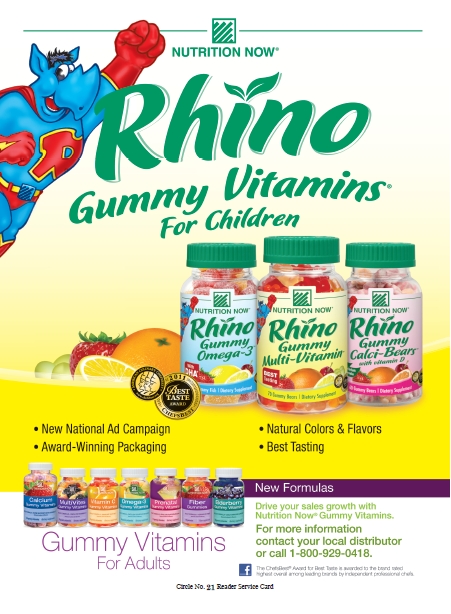 Neil E. Levin, CCN, DANLA, nutrition education manager of NOW Foods, Bloomingdale, IL, says plant proteins are more dilute than that of animals.
Neil E. Levin, CCN, DANLA, nutrition education manager of NOW Foods, Bloomingdale, IL, says plant proteins are more dilute than that of animals.
Trisha Sugarek, B.S., M.S., national educator/ R&D specialist at Bluebonnet Nutrition Corporation, Sugar Land, TX, recommends some more guidelines for feeding vegetarian kids:
• Have multiple eating times (three meals and two to three snacks, totaling 1,800 calories/day for children three to six years old).
• Avoid excessive amounts of bran and bulky foods (phytates inhibit the absorption of some nutrients).
• Provide energy-dense foods like avocados and cheese.
• Provide enough fat (at least 30% of total calories) from good sources like omega 3 fatty acids, canola or soybean oil.
• Provide foods fortified with vitamins B12 and D, as well as calcium.
But, Melissa Burton of Goody Good Stuff reminds us that when offering supplements to vegan and vegetarian families, be sure encapsulated formulas are in veggie caps, as gelatin capsules are not vegetarian.
Soy: yea or nay? One question vegetarian and other families may have is whether or not to limit soy in children’s diets. According to Jonny Bowden, scientific advisor to Barlean’s Ferndale, WA, one could make a strong case for both sides. “I personally would keep soy to a minimum and keep it exclusively from natural fermented foods like miso, soy sauce, tempeh, etc.,” he states. “I think there’s a strong enough argument to be made that the estrogenic effect of some of the phytoestrogens in soy—no matter how ‘mild’ they may be—are probably best not added to a child’s developing hormonal universe.”
Foster further explains why the estrogen-like substances found in some plants could be problematic, though she notes, “the research in this area is widely (and sometimes hotly) debated.” Opponents to soy feel phytoestrogens could negatively affect endocrine system health and thyroid function, for instance. Foster says, “In 1998, the New Zeala nd Ministry of Health issued an advisory opinion recommending cow’s milk formula over soy formula, and in 1999 the Canadian Health Coalition called on the Canadian government to restrict the use of soy formulas. The American Academy of Pediatrics (AAP) recommends that parents give soy formula only to infants who cannot digest cow’s milk or to infants whose parents wish them to follow a vegan diet.”
nd Ministry of Health issued an advisory opinion recommending cow’s milk formula over soy formula, and in 1999 the Canadian Health Coalition called on the Canadian government to restrict the use of soy formulas. The American Academy of Pediatrics (AAP) recommends that parents give soy formula only to infants who cannot digest cow’s milk or to infants whose parents wish them to follow a vegan diet.”
Marshall believes eating too much soy can also negatively affect one’s omega-3 to omega-6 ratio. “Soy oil and soy flour are being added at rapid rates to the food chain because it is an inexpensive ingredient. As a result, people are becoming overexposed, and eating too much soy, and hence raising their omega-6 fatty acid levels creating greater inflammatory imbalance in the bodies.”
Those that favor soy in the diet say civilizations having been eating large amounts of soy for centuries without any ill effects. Some experts even believe that soy offers protection against cancer (3). “In fact, one study indicated that it was the use of soy consumed at a younger age that may protect against breast cancer later in life,” Burks says.
Sugarek points out some other health benefits of soy, which include being a “wonderful source of high-quality, vegetarian protein.” She adds that soymilk offers many of the same nutrients as cow’s milk such as calcium, vitamin D, potassium, riboflavin and vitamin B12.
Levin also points to some of the many benefits of plant estrogens: “There is even evidence that the childhood consumption of soy foods is protective for adults later in life…most scientific reviews rate it highly as a protective, antioxidant-rich superfood. This scientific record of safety applies to non-fermented and fermented soy alike. But, like any food, it is best not to consume soy in excess or obsessively; variety of diet is always best.” He feels the only time one should limit soy is during an infant’s first few months of life because of possible allergic reactions.
The type of soy consumed is a factor, too. For instance, Chapman warns that soy-based meat alternatives are a good source of protein while being low in fat and cholesterol, but they may contain too much sodium. “Soy is best consumed as it is in traditional Asian diets—as tofu, as edamame, etc.—and best when not used as a child’s main source of lean protein.” Fermented soy products, Martie Whittekin, a nutritional expert for Continental Vitamin Company, Los Angeles, CA, adds, “benefit from the fermenting organisms and are easier to digest.”
And, Levin recommends avoiding GMO soy, “which may be more difficult to digest and may present problems as to the bioavailability of nutrients.”
Non-milk drinkers. Parents of children that cannot drink milk due to an intolerance or allergy may be concerned that their kids aren’t getting enough calcium for optimal bone health. But, Bowden says they may not need to worry. He states, “There is no correlation between ‘strong bones’ and ‘high dairy consumption. In fact, many countries where they don’t drink milk at all have low rates of osteoporosis,” he states.
Non-dairy sources of calcium include kale and spinach, fortified orange and grapefruit juice and nut milks (like almond milk), according to Bowden.
Chapman reminds us that any parent who wants to support bone health should be sure their children also get enough vitamin D from food sources like cold water fish, egg yolks or cod liver oil.
But, consider this important point from Meletis: “Since kids are not naturally drawn to such food sources, I routinely use a good calcium-rich multivitamin and vitamin D.”
Foster underscores the importance of vitamin D, noting “a minimum 400 IU per day are currently recommended for all newborns, infants and children by the AAP.”
And, Whittekin adds that calcium-rich almonds, broccoli and leafy, green vegetables also contain magnesium, which supports bone health, too.
Gluten-free diet. According to Burks, children on a gluten-free diet have the same dietary concerns as other children and need pretty much the same supplements. He cites a 2010 study that found, “Children on [a gluten-free diet] appear to follow the same trends as healthy children on a normal diet, with high intakes of saturated fat and sucrose and low intakes of dietary fiber, vitamin D and magnesium compared to recommendations” (4).
 But, Whittekin warns parents against using corn as a substitute too often. She states, “Corn is low in the amino acids l-lysine and l-tryptophan and is quite high on the list of common allergens.”
But, Whittekin warns parents against using corn as a substitute too often. She states, “Corn is low in the amino acids l-lysine and l-tryptophan and is quite high on the list of common allergens.”
However, when children are first diagnosed with something like celiac disease they may be lacking certain vitamins and minerals. “These deficiencies can be caused by malabsorption of nutrients due to a damaged or irritated lining of the small intestine, and/or by depletion due to persistent diarrhea. Calcium, vitamin D, iron, and B-vitamins (particularly riboflavin) are all nutrients that are especially important to be aware of in these children,” says Foster.
Reversing Childhood Obesity
Nearly 17% of children in the United States (that’s 12.5 million kids) are obese (5). This number has been markedly increasing for about two decades. Of course, being severely overweight is far from being a problem of aesthetics. Rather, these children (and others who are simply eating a poor diet) face numerous health issues like elevated blood sugar levels and blood pressure.
Many feel the only hope for today’s youth is education, and a natural products retailer has an important role to play here. First, they can be sure parents are aware of why processed foods should be limited or eliminated from a child’s diet. “It is important to return to the family dinner table and have family meals that are not based on take-out foods and pizza; rather, they are based on whole foods such as fresh fruits and vegetables, lean animal protein and whole grains,” states Marshall.
Storeowners shouldn’t be shy about offering tips and tools parents can use to raise healthy kids. Says Birkner, “Naturals retailers can really shine in this area, and be that community education leader.” Here are some merchandising tips that can help families with children be excited about healthy meals:
• Post a sign by your fruit offerings reminding families that they make a great dessert.
• Host an educational seminar about how parents can swap unhealthy ingredients for healthy ones in kids’ favorite recipes. Says Bowden, “This should dovetail nicely with the retailer’s interests, as those ‘healthy swap’ foods and ingredients are likely to be found right at your store!”
• Birkner suggests offering to be a resource for or to write a column about healthy foods in your local paper. She adds, “Explain exactly why by pitting the ‘good’ chicken nuggets against the ‘bad’ chicken nuggets, for example: highlight the differences found on the labels. Use this column also to tout the benefits of fruits, vegetables, nuts, etc., and provide an easy recipe.”
• Don’t forget kid-friendly sampling in your store, since “If it does not pass the taste test of the kid, the parent is not going to want to spend hard earned cash on something that will get vetoed the moment it gets home,” Meletis states.
• Host a kid-focused event to teach children about nutrition. Pass out a list of athletic opportunities in your area for kids.
• Birkner suggests hosting a parents’ club. “Hold bi-weekly events where parents can learn and mingle, and browse your store. Encourage questions and feedback—inspire the sense of community,” she states.
• Use social media sites (like Twitter and Facebook) to market your store’s offerings of kid-friendly foods, supplements and personal care items. You can also use them as forums to discuss news and new research about kids’ health issues.
• Make your store inviting to little ones by having a play area.
• Burks suggests partnering with local businesses to host a 5K run with prizes. “Imagine: a fitness gym provides winners with a membership, a health food store offers a wellness basket, a local massage therapist donates a half hour massage, etc. By partnering with others, each can widen their target market to include new potential customers. Greater still is the impact on the community.”
• Create a flyer for families that has healthy lifestyle tips from the American Heart Association like limiting computer/video game/television time; don’t reward kids with foods; setting daily goals for physical activity; organizing family walks/bike rides/playground time; and making a game of reading food labels.
Overall, it’s important to stress to families that now is the time to teach kids about wellness, since our eating and lifestyle choices are highly influenced by what we learned before our teenage years. Says Andreas Koch, Barlean’s marketing director, “The good news is that the natural products industry has made paramount strides in the last 10 years offering healthy foods that are actually very tasty. All-natural healthy foods are now as delicious as the typical mass ‘empty’ foods we’ve consumed for so many decades. It is now just a matter of time and open-mindedness for parents of obese children to make the switch.”
Appropriate balance. One  can hardly blame a child for being drawn to sugary and fatty foods which are tempting—and even addictive. The reason why, Sugarek says, is that sugar and fat “allow enzymes to trigger brain signals for the desire or need of foods that are unhealthy.”
can hardly blame a child for being drawn to sugary and fatty foods which are tempting—and even addictive. The reason why, Sugarek says, is that sugar and fat “allow enzymes to trigger brain signals for the desire or need of foods that are unhealthy.”
This biological effect was studied in rats by neuroscientist Ann Kelley from the University of Wisconsin Medical School. Kelley gave rats a synthetic opioid enkephalin, which is produced in the body after allergenic foods are eaten. “Someone who is addicted to these chemicals from their food supply can suffer from withdrawal symptoms when access to that particular food is denied,” says Sugarek. The rats given this chemical, in fact, ate six times their normal amount. “Kelley recognized long-lasting changes in rats’ brain chemistry—similar to those caused by extended use of morphine or heroin,” says Sugarek.
She cites Kelley, who stated, “This says that mere exposure to pleasurable tasty foods is enough to change gene expression and that suggests that humans can become addicted to food.”
Ironically, many children who have plenty to eat are malnourished because they are making poor food choices. Therefore, says Sugarek, “providing youngsters with dietary supplements to fill the gaps in their daily nutrition can be enormously beneficial - at least ensuring the appropriate amounts of vitamins and minerals for healthy development at a cellular level.”
Sugarek offers a table of how various nutrients affect a child’s growth and development (see below).
Red Light TV, Green Light Playground
Having spoken about childhood obesity, one would be remiss not to mention that millions of U.S. kids are living healthy lifestyles. Many kids and teens are physically active, whether it’s playing on a school sports team, taking dance lessons or the like.
living healthy lifestyles. Many kids and teens are physically active, whether it’s playing on a school sports team, taking dance lessons or the like.
Physically active kids and teens have their own nutritional needs, especially because they need sustained energy throughout their activities. Says Burton, “Children who are very active need more fuel. Parents should take care to ensure their kids are getting the best possible nutrients and fuels without artificial additives that can be dangerous and have very unattractive side effects.”
Such foods could include healthy carbs, says Birkner, like the complex variety found in vegetables, oatmeal or whole grain bread.
Kids expending a lot of energy also should maintain and replace electrolytes, but not with sugary, caffeinated sports drinks. According to Burks, “Some say that caffeine may increase mental acuity or stamina, but the weight of research hasn’t proven this. On the other hand, there is a lot of research that shows the risks of caffeine outweigh its potential benefits.” He cites a study that analyzed the effect of carbohydrate-electrolyte fluids on cycling performance (6). The results were influenced by “rate of perceived exertion,” he says.
Electrolyte water and add-ins are better choices. Bowden advocates the use of greens drinks, which “can go a long way toward stabilizing blood sugar, replacing nutrients, and keeping energy up.” Or, Foster suggests an effervescent multi (Children’s Oxylent from Vitalah) that doubles as a flavored drink.
Others recommend active kids eat protein at every meal and snack. Says Levin, “Natural protein bars and whole fruits are great snacks, as are controlled servings of nuts, seeds and trail mixes…The safest supplements for youth athletes are all-natural protein and electrolyte-replacer formulas.”
 The B-vitamins can also offer sustained energy, while omega-3s offer the anti-inflammation benefits that athletes need, says Bowden. Marshall adds some information about the importance of omegas on the mood of teen athletes, “who are a very vulnerable population,” she states. “Teens notoriously do not eat well, so consumption of healthy fat in the form of fish oil supplements provides tremendous overall support for their rapidly growing bodies.”
The B-vitamins can also offer sustained energy, while omega-3s offer the anti-inflammation benefits that athletes need, says Bowden. Marshall adds some information about the importance of omegas on the mood of teen athletes, “who are a very vulnerable population,” she states. “Teens notoriously do not eat well, so consumption of healthy fat in the form of fish oil supplements provides tremendous overall support for their rapidly growing bodies.”
Meletis says vitamin D may offer some benefits specific to young athletes, too. He speaks of new research from Michael Shindle, M.D., of Summit Medical Group, Morristown, NJ, on 89 professional football players with muscle injuries. The researcher found that 80% of the team was vitamin D deficient and “African American players and players who suffered muscle injuries had significantly lower levels.”
All kids (especially active kids) should take a multivitamin, too.
Your Youngest Clients
While formula-fed infants should be getting all the nutrients they need from the bottle, breast-fed babies may require some additional nutritional support. For instance, vitamin D is notoriously lacking in breast milk. Says Whittekin, “Because vitamin D deficiency is so widespread, it isn’t surprising that vitamin D is often found to be low in breast milk.”
Foster says that fully or partially breastfed babies 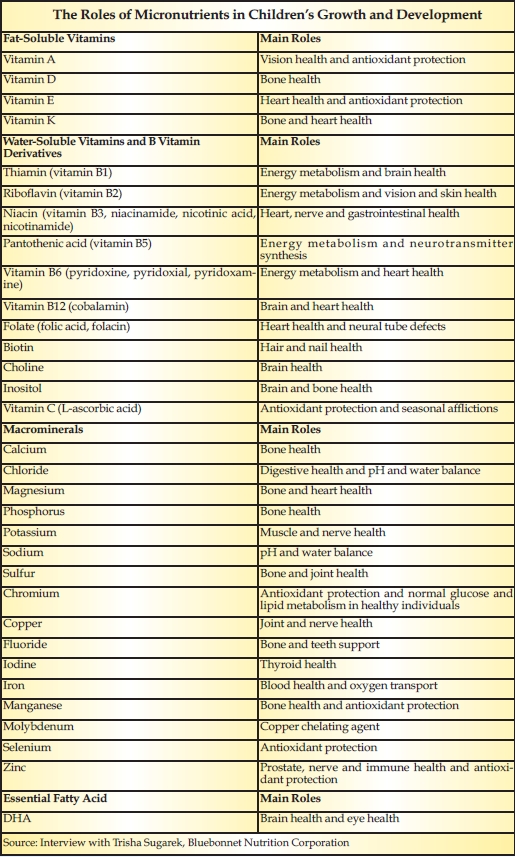 (and infants that drink less than 32 ounces of formula daily) should take 400 IUs of vitamin D from day one, according to the AAP. Just be sure parents purchase an infant-specific formula (with an appropriately sized dropper) for little ones and that they talk with their pediatricians before dispensing it. She also suggests moms take an easily digestible vitamin D supplement, possibly in a form like an effervescent that fits into their routines.
(and infants that drink less than 32 ounces of formula daily) should take 400 IUs of vitamin D from day one, according to the AAP. Just be sure parents purchase an infant-specific formula (with an appropriately sized dropper) for little ones and that they talk with their pediatricians before dispensing it. She also suggests moms take an easily digestible vitamin D supplement, possibly in a form like an effervescent that fits into their routines.
Breastfeeding moms should continue to take their prenatals while nursing, since “the quality of breast milk may depend on the mother’s nutritional status,” says Levin. They also should continue taking DHA and EPA, provided it is highly purified and safe for pregnancy and nursing.
Young children can also start taking DHA early (with a pediatrician’s permission). “If an infant is bottle fed, most formulas contain DHA,” says Marshall. Nonetheless, “It is appropriate for a child with specific health concerns to start taking DHA immediately. Regular DHA, or even fish oil supplement use specifically, can and should be started very early.” Just be sure about dosing before giving to small children. Baby-specific DHA formulas are available (like Nordic Naturals Baby DHA), which are dosed with body weight in mind.
Once a child is eating solids, says Root, “DHA can be added to their diet, by incorporating a daily dose in fruit or another food. Calamari source DHA is available in a lemon-flavored liquid that can be added to foods or Cod Liver Oil is available that provides both the DHA and some vitamin D.”
Sullivan reminds us why parents should consider DHA supplementation. A growing body of evidence, she says, indicates “DHA is important for optimal infant brain, eye and nervous system development, and has been shown to support a healthy pregnancy.” It also has research support for its use for healthy attention and focus in children. A 2010 study from the Journal of Pediatrics found five-year-olds whose mothers took DHA supplements for the first four months of breastfeeding performed better on a test of sustained attention. Says Sullivan, “This, along with the 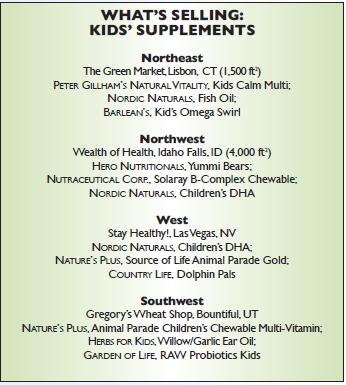 previously reported better performance of the children of DHA-supplemented mothers on a test of psychomotor development at 30 months of age, suggests that DHA intake during early infancy may provide long-term neurodevelopment benefits.”
previously reported better performance of the children of DHA-supplemented mothers on a test of psychomotor development at 30 months of age, suggests that DHA intake during early infancy may provide long-term neurodevelopment benefits.”
A deficiency in DHA, says Kaori Shimazaki Dadgostar, Ph.D., technical specialist for Jarrow Formulas, Los Angeles, CA, could cause impaired mental and visual function.
James Liu, general manager of SeaBuckWonders, a division of Health King Enterprise & Balanceuticals Group, Chicago, IL, reminds us that kids can benefit from omegas other than just DHA. For instance, sea buckthorn provides omegas-3, -6, -7 and -9 plus various flavonoids, carotenoids, micro and macro elements. “The high content of omega-3, -6 and -9 is excellent for the brain by helping kids with mental focus and memory,” he says.
With regard to other supplements, parents can make use of kids’ herbal supplements (upon consultation with a healthcare provider). One such category is for upper respiratory system, nasal health and the immune system. “Since our young ones are daily interacting with lots of kids at school, they have a tendency toward catching what is going around. Many of their health issues involve sinus symptoms,” says Eileen Sheets, managing director of Bioforce USA, Ghent, NY (which now owns the Bionorica brands).
The benefit of herbal immune-support supplements is that, unlike many cold/flu drugs, they don’t contain stimulants such as caffeine. For instance one brand (Sinupret for Kids) combines European Elder, Common Sorrel, Cowslip, European Vervain and Gentian, and is included in a product-specific American Botanical Council monograph that discusses its safety and efficacy.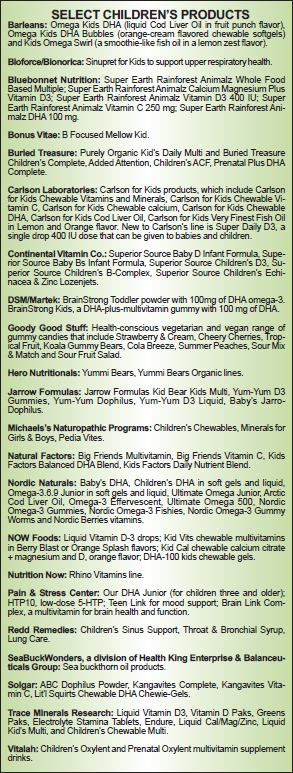
“This is good news for parents, since the U.S. Food and Drug Administration advised parents not to administer cold and flu remedies to young children less than two years of age, plus it is reviewing their safety for older children,” Sheets explains.
Last, some kids may need extra iron, if a doctor recommends it. Dadgostar also warns parents to be careful about iron supplements or prenatals containing iron: “Accidental overdose of iron-containing products is a leading cause of fatal poisoning in children under six. Please make sure to keep supplements out of the reach of babies and children. In case of accidental overdose, call a doctor or poison control center immediately.”
When to start probiotics? Parents may wonder when it is appropriate to give children probiotics, once a doctor says it’s okay. Whittekin feels the beneficial bacterial are “critical” to infants’ and children’s health because they affect immune and digestive health. Vaginally delivered babies may receive their first dose of the bugs in the birth canal, but C-section babies don’t. She states, “Supplementation has become even more important now that nearly one-third of births are by C-section. It is never too early to replenish the friendly flora if it is done the right way with the right product.”
While beneficial bacteria may be transferred from mother to baby, “high-quality probiotics may be beneficial for the babies in order to ensure the maintenance of healthy intestinal microflora,” says Dadgostar.
Levin adds some words to the wise: “Be cautious about obsessive loading of these formulas. Acidophilus overgrowth, though rare, has been reported in infants whose parents overdid supplementation.”
Thus, he feels it’s important to give babies and children age-appropriate formulas since probiotics offer different strains to infants versus older children. Adds Dadgostar, “Common strains of bacteria that are used in clinical studies in infants and children include Lactobacillus reuteri, Lactobacillus GG, Bifidobacterium lactis, Bifidobacterium breve and Bifidobacterium longum.” She says children should start with low doses of probiotics at first, too. WF
References
1. S. Hood, “The Vegan Diet,” Practice Nurse, 35 (3), (2008).
2. T.A. Sanders and R. Purves “An Anthropometric and Dietary Assessment of the Nutritional Status of Vegan Preschool Children,” J. Hum. Nutr. 35 (5), 349–357 (1981).
3. J. Stubert and B. Gerber, “Isoflavones—Mechanism of Action and Impact on Breast Cancer Risk,” Breast Care, 4 (1), 22–29 (2009)
4. K. Ohlund et al., “Dietary Shortcomings in Children on a Gluten-Free Diet,” J. Hum. Nutr. Diet. 23 (3), 294–300 (2010).
5. Centers for Disease Control and Prevention, “Overweight and Obesity,” www.cdc.gov/obesity/data/trends.html, accessed July 29, 2011.
6. M.S. Ganio et al., “Effect of Various Carbohydrate-Electrolyte Fluids on Cycling Performance and Maximal Voluntary Contraction,” Int. J. Sport Nutr. Exerc. Metab., 20 (2), 104–114 (2010).
Published in WholeFoods Magazine, September 2011










